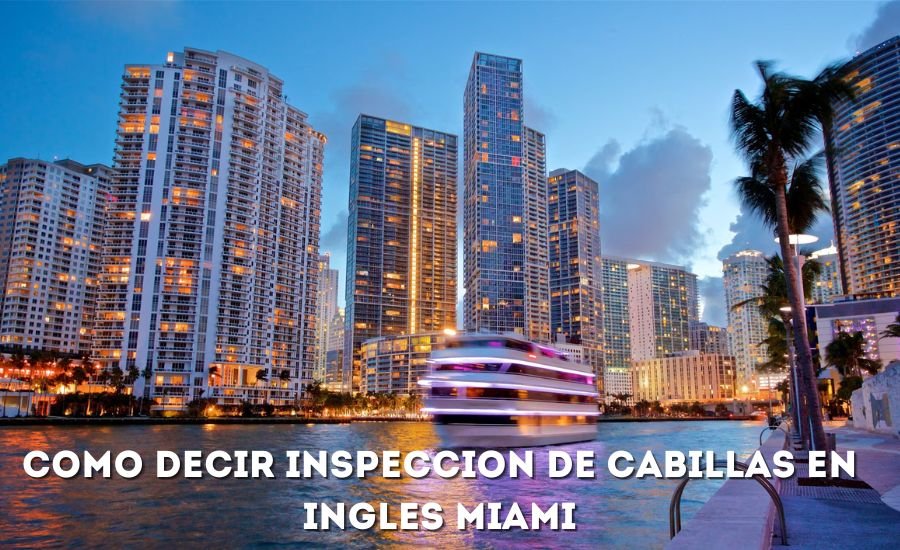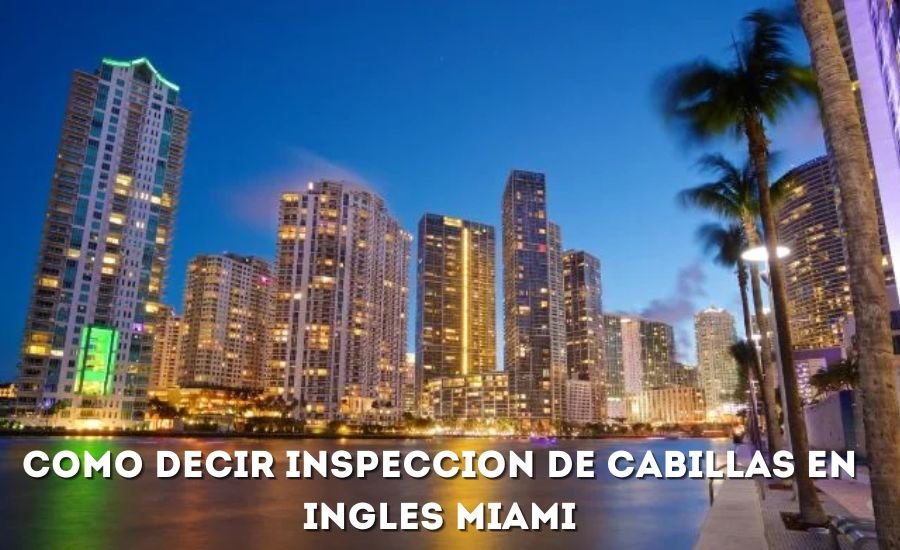Como Decir Inspección de Cabillas en Inglés Miami: A Comprehensive Guide to Rebar Inspections

In Miami’s fast-paced construction world, understanding critical terms like “inspección de cabillas” and knowing how to translate them accurately into English is essential for successful projects. Whether you are a contractor, architect, or someone working in the industry, being familiar with the translation “como decir inspección de cabillas en inglés Miami” can make communication smoother and more efficient. This article will guide you through the importance of rebar inspections, why they matter in Miami’s unique environment, and how to use this vital term in English.
Why Rebar Inspections Matter in Construction
Rebar, or reinforcing steel bars, supports concrete structures, ensuring strength and stability. In Miami, where environmental factors such as humidity, salt exposure, and fluctuating temperatures are constant challenges, rebar inspections are vital to maintaining the integrity of buildings. Understanding the term “inspección de cabillas” in English, or rebar inspection, is as crucial as the inspection itself.
Key Reasons Why Rebar Inspections Are Critical in Miami:
- Preventing Structural Failures: Rebar is what strengthens concrete structures. Without proper inspection, buildings could be at risk of collapse.
- Miami’s Climate Demands More Attention: The coastal environment accelerates rust and corrosion, making rebar inspections an ongoing priority.
- Meeting Building Code Requirements: Miami’s strict building codes, especially after Hurricane Andrew in 1992, require thorough inspections to ensure public safety.
What Is Rebar and What Is Its Role in Construction?
Rebar, also known as “cables” in Spanish, refers to the steel bars that reinforce concrete in various construction projects. These bars play a critical role in ensuring the durability and strength of structures, preventing cracks, and distributing weight evenly.
In Miami, where the city’s skyline is constantly growing with new buildings, having robust rebar systems is non-negotiable. Here’s a closer look at why rebar is so essential:
- Preventing Cracking: Rebar helps distribute the tension that concrete alone cannot handle.
- Reinforcing Durability: Properly placed rebar ensures buildings can withstand environmental pressures like Miami’s hurricanes and floods.
By understanding the importance of rebar, you’ll see why regular inspections, or “inspección de cabillas,” are necessary to ensure the longevity of Miami’s architectural developments.
Translating “Inspección de Cabillas” to English
Translating construction terms can sometimes lead to misunderstandings on multilingual job sites, especially in a diverse city like Miami. The term “inspección de cabillas” translates directly to “rebar inspection.” However, the importance lies in fully understanding the scope of the inspection.
Rebar inspection involves more than just a visual check. It’s about ensuring the steel bars are positioned correctly, covered adequately by concrete, and free from rust or damage. This inspection is crucial before the concrete is poured.
Critical Elements of Rebar Inspections:
- Proper Spacing: Ensuring bars are evenly spaced to provide uniform support.
- Concrete Coverage: Checking that the rebar is sufficiently covered by concrete to prevent exposure to the elements.
- Rust and Corrosion: Inspect for any signs of deterioration that may weaken the structure.
Using “como decir inspección de cabillas en inglés Miami” correctly ensures better communication between contractors and inspectors on multilingual job sites, avoiding costly errors.
The Rebar Inspection Process in Miami
In Miami, rebar inspections must meet stringent guidelines due to the city’s climate and strict building codes. Rebar inspections generally take place in two phases: pre-pour and post-pour inspections.
- Pre-Pour Inspection: Before the concrete is poured, inspectors ensure that the rebar is placed correctly, aligned with the project’s blueprints, and free of any visible damage.
- Post-Pour Inspection: After the concrete has been poured and set, inspectors check to ensure there are no visible structural issues, such as cracks, and that the concrete properly encases the rebar.
Checklist for Rebar Inspections:
- Placement: Is the rebar positioned according to the design plans?
- Spacing: Are the bars spaced appropriately to ensure even support?
- Concrete Coverage: Is there enough concrete covering the rebar to protect it from moisture?
- Rust/Corrosion: Are there any signs of rust or corrosion that could weaken the structure?
Importance of Miami’s Building Codes for Rebar Inspections
After the devastating effects of Hurricane Andrew in 1992, Miami implemented much stricter building codes to protect against future disasters. These codes include specific guidelines for rebar inspections, particularly for coastal buildings.
Miami’s unique environmental factors, such as salt air and high humidity, mean construction materials are under constant stress. Rebar can corrode much faster in this environment, weakening structural integrity if not inspected regularly.
Critical Updates to Miami’s Building Codes:
- Mandatory 40-Year Recertification: Buildings that reach 40 years old must undergo a complete recertification, which includes a detailed rebar inspection.
- Enhanced Coastal Regulations: Buildings near the coastline must follow additional guidelines to prevent saltwater corrosion.
- Structural Integrity Testing: Miami requires frequent testing and inspections of older buildings to ensure they meet updated safety standards.
Adhering to these building codes ensures that Miami’s skyline remains safe and that projects meet regulatory requirements.
Read More Like This: Condominio-Garage-DI-Proprieta-Nega-Autorizzazione-Cappotto-Superbonus-110
Common Issues Found During Rebar Inspections
Even in the most well-managed construction projects, issues can arise with rebar placement or materials. Common problems found during inspections in Miami include:
- Corrosion: Due to Miami’s coastal location, rebar is highly susceptible to corrosion from saltwater exposure. Rust can weaken the bars, making them less effective at reinforcing concrete.
- Improper Placement: Incorrect rebar placement can lead to structural instability. Inspectors often find that bars need to be spaced correctly, reducing the strength of the concrete.
- Concrete Coverage Issues: Sometimes, rebar needs to be sufficiently covered by concrete, leaving it vulnerable to the elements.
- Damage from Nearby Construction: Vibrations from adjacent construction projects can shift or damage rebar in existing buildings.
Finding a Reliable Rebar Inspection Company in Miami

Choosing the right rebar inspection company ensures your project meets Miami’s stringent standards. Here’s what to look for when hiring professionals:
- Certifications and Experience: Ensure the company has certified inspectors with experience in rebar inspections, especially in Miami’s coastal climate.
- Familiarity with Local Codes: The company must be knowledgeable about Miami’s specific building codes and recertification processes.
- Reputation and Reviews: Look for reviews or ask for recommendations from other contractors or developers in the area.
- Clear Communication: The inspection company should be able to clearly explain the results of their findings and suggest appropriate solutions for any issues.
Conclusion
In Miami’s construction industry, understanding the importance of rebar inspections, or “inspección de cabillas,” is vital for ensuring safety and regulatory compliance. With Miami’s unique environmental challenges, such as humidity and coastal exposure, inspections are not just a formality—they are essential for preventing structural failures.
Whether you’re a contractor or architect, knowing how to say “inspección de cabillas” in English (“rebar inspection”) and ensuring proper inspection practices will enhance the safety and success of your projects. Clear communication, adherence to local building codes, and the use of certified professionals are the critical elements to surpassing competitors and maintaining high standards in Miami’s bustling construction landscape.
By following the steps outlined in this article, you can ensure that your construction projects are not only up to code but are also structurally sound, offering long-term safety and durability.
FAQs
Q: What is a rebar inspection?
A: A rebar inspection checks that reinforcing steel bars (rebars) in a concrete structure are correctly placed, aligned, and covered to ensure the building’s strength and stability.
Q: How often should rebar inspections be done in Miami?
A: Rebar inspections are required during the 40-year recertification process, but they should also be conducted regularly during the construction phase to ensure structural integrity.
Q: Can weather conditions in Miami affect rebar quality?
A: Yes, Miami’s humid coastal climate accelerates rust and corrosion, making regular rebar inspections essential to prevent structural failures.
Q: Why is rebar inspection necessary before pouring concrete?
A: Inspecting rebar before pouring concrete ensures that the steel bars are correctly placed and spaced, which helps prevent structural issues. It also provides the rebar is free from rust or damage that could weaken the foundation.
Q: What happens if the rebar needs to be properly inspected?
A: If rebar is not inspected correctly, it can lead to severe structural problems, including cracks in the concrete, compromised strength, and even the risk of collapse in extreme cases. Regular inspections ensure the long-term safety and durability of the building.
Read Next: Pokigoru-Net

Specializing in insightful and engaging articles across a range of topics. With a keen eye for detail and a passion for delivering high-quality information, Mary helps readers stay informed with the latest trends and updates


